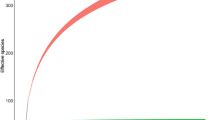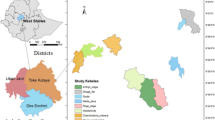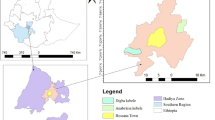Abstract
Trees are important components of agricultural landscapes in different parts of Ethiopia, and information on their type, diversity and distribution in sub-humid agroecologies is essential for designing interventions. A study was conducted to evaluate tree diversity and their spatial patterns in agricultural landscapes under different land use categories in four selected sub-humid sites in Western Oromia, Ethiopia. Tree inventory was conducted on 100 homesteads (19 ha), 18 crop lands (35 ha) and 11 grazing lands (5.5 ha) belonging to 100 randomly selected households. A total of 82 tree species were identified: 67 in the homesteads, 52 in the crop lands and 29 in the grazing lands. The density of trees varied from 68 trees per ha in crop lands to 801 trees per ha in homesteads. Diversity indices revealed that homestead was the most diverse with Shannon index of 2.42, and Simpson index of 0.84. The density of trees among the tree communities in the four sites varied from 133 in Bako Tibe to 476 in Jima Arjo, but not any one of the sites had more diverse tree community as revealed by the Rènyi diversity profiles analysis. The three dominant tree species in the agricultural landscapes were Eucalyptus camaldulensis, Vernonia amygdalina and Cordia africana. Pearson correlation analysis showed that high tree species density, richness and diversity had high association with homesteads than with crop lands and grazing lands. It also revealed significant positive correlations between land size and evenness, and latitude and evenness whereas there were significant negative correlations between family size and Shannon diversity index, and land size and tree density. The majority (81.6%) of the trees were established through plantation and only 18.4% were regenerated naturally. The proportion of planted trees varied from 68% in Gobu Seyo to 94.1% in Guto Gida. The study showed that agricultural landscapes harbour high diversity of tree species with a spatial pattern, and increasing the tree cover with focus in the crop lands is essential for improved resilience of the agricultural systems and for circa-situm conservation of biodiversity.




Similar content being viewed by others
References
Abate A, Tamrat B, Sebsebe D (2006) The undifferentiated afromontane forest of Denkoro in the central highland of Ethiopia: a floristic and structural analysis. Ethiop J Sci 29:45–56
Abebe T (2005) Diversity in Homegarden Agroforestry Systems of Southern Ethiopia. Tropical Resource Management Papers, No. 59. 143 pp
Asfaw Z, Hulten H (2003) Tree diversity management in the traditional agroforestry land use of Sidama, Southern Ethiopia. Acta Univ Agric Suec Silv 263(1):1–28
Backes MM (2001) The role of indigenous trees for the conservation of bio-cultural diversity in traditional agroforestry land use systems: the Bungoma case study in situ conservation of indigenous tree species. Agrofor Syst 52:119–132
Boffa JM, Kindt R, Katumba B, Jourget JG, Turyomurugyendo L (2008) Management of tree diversity in agricultural landscapes around Mabira Forest Reserve, Uganda. Afr J Ecol 46(1):24–32
Chao A, Jost L (2012) Coverage-based rarefaction and extrapolation: standardizing samples by completeness rather than size. Ecology 93(12):2533–2547
Colwell RK (2009) Biodiversity: concepts, patterns and measurement. In: Levin SA (ed) The Princeton guide to ecology. Princeton University Press, Princeton, pp 257–263
Colwell RK (2013) Estimate S: Statistical estimation of species richness and shared species from samples. Version 9. Persistent. www.purl.oclc.org/estimates
Derero A, Bekele T, Näslund B (2003) Population structure and regeneration of woody species in a broad-leaved Afromontane rainforest, southwest Ethiopia. Ethiop J Nat Resour 5(2):255–280
Duguma LA, Hager H (2010) Woody plants diversity and possession, and their future prospects in small-scale tree and shrub growing in agricultural landscapes in central highlands of Ethiopia. Small Scale For 9:153–174
Endale Y, Derero A, Argaw M, Muthuri C (2017) Farmland tree species diversity and spatial distribution pattern in semi-arid East Shewa, Ethiopia. For Trees Livelihoods 26(3):199–214
Gotelli, NJ, Colwell RK (2011) Estimating species richness. In: Magurran AE, McGill BJ (eds) Frontiers in measuring biodiversity. Oxford University Press, New York, pp 39–54
Harvey CA, Haber WA (1999) Remnant trees and the conservation of biodiversity in Costa Rican pastures. Agrofor Syst 44:37–68
Ib F, Sebsebe D, Breugel PV (2010) Atlas of the potential vegetation of Ethiopia. The Royal Danish Academy of Sciences and Letters, Denmark, 307p
Iiyama M, Derero A, Kelemu K, Muthuri C, Kinuthia R, Ayenkulu E, Kiptot E, Hadgu K, Mowo J, Sinclair FL (2017) Understanding patterns of tree adoption on farms in semi-arid and sub-humid Ethiopia. Agrofor Syst 91:271–293
Isango JA (2007) Stand structure and tree species composition of Tanzania Miombo Woodlands: a Case Study from Miombo Woodlands of Community Based Forest Management in Iringa District. Working Papers of the Finnish Forest Research Institute 50: 43–56
Kindt R (2016) BiodiversityR: package for community ecology and suitability analysis. Version 2.7-1. URL https://CRAN.R-project.org/package=BiodiversityR
Kindt R, Coe R (2005) Tree diversity analysis. A manual and software for common statistical methods for ecological and biodiversity studies. World Agroforestry Centre (ICRAF), Nairobi, Kenya, 207 pp
Kindt R, Degrande A, Turyomurugyendo L, Mbosso C, Van Damme P, Simons AJ (2001). Comparing species richness and evenness contributions to on-farm tree diversity for data sets with varying sample sizes from Kenya, Uganda, Cameroon, and Nigeria with randomized diversity profiles. In: IUFRO Conference on Forest Biometry, Modelling and Information Science, 26–29 June 2001. University of Greenwich, UK. http://cms1.gre.ac.uk/conferences/iufro/proceedings
Kindt R, Simons AJ, Damme PV (2004) Do farm characteristics explain differences in tree species diversity among Western Kenyan farms? Agrofor Syst 63:63–74
Kindt R, Van Damme P, Simons AJ (2006) Tree diversity in western Kenya: using profiles to characterise richness and evenness. Biodivers Conserv 15:1253–1270
Kiptot E, Kinuthia R, Kelemu K, Mebrahtu T (2013) ACIAR baseline survey ‘trees for food security project’ the agricultural extension system in Ethiopia: A focus on East Shewa, West Shewa and East Wollega Zones
Krebs CJ (1989) Ecological methodology. University of British Colombia, Harper Collins, NewYork
Lengkeek AG, Kindt R, van der Maesen LJG, Simons AJ, van Oijen DCC (2005) Tree density and germplasm source in agroforestry ecosystems in Meru, Mount Kenya. Genet Res Crop Evol 52:709–721
Magurran AE (2004) Measuring biological diversity. Blackwell, Oxford, p 256
Moreno-Calles A, Casas A, Blancas J, Torres I, Masera O, Caballero J, Garcia-Barrios L, Pe´rez-Negro´n E, Rangel-Landa S (2010) Agroforestry systems and biodiversity conservation in arid zones: the case of the Tehuaca´n Valley, Central Me´xico. Agrofor Syst 80:315–331
Perera AH, Rajapakse NRM (1991) A baseline study of Kandayan forest gardens of Srilanka: structure, composition and utilization. For Ecol Manag 45:269–280
Perfecto I, Vandermeer J (2002) Quality of agroecological matrix in a tropical montane landscape: ants in coffee plantations in southern Mexico. Conserv Biol 16:174–182
Polasky S, Nelson E, Lonsdorf E, Fackler P, Starfield A (2005) Conserving species in a working landscape: land use with biological and economic objectives. Ecol Appl 15(4):1387–1401
Power AG, Flecker AS (2001) Agroecosystems and Biodiversity. Smithsonian Migratory Bird Center. http://natzoo.si.edu/smbc/Research/Caca/power.htm
Schroth G, Da Fonseca GAB, Harvey CA, Gascon C, Vasconcelos HL, Izac AMN (eds) (2004) Agroforestry and biodiversity conservation in tropical landscapes. Island Press, Washington, DC
Sharma BM (1997) Nutrient cycling in agroforestry. In: Gupta JP, Sharma BM (eds) Agroforestry for sustained productivity in arid regions. Pawan Kumar Scientific Publishers, Jodhpur, pp 69–77
Shumba E (2001) Biodiversity and planning support programme. Zimbabwe case study. Indonesia, Forestry Commission
Teshome DS (2014) Assessment of tree species, diversity distribution patterns and socioeconomic uses on agricultural landscapes: A case of Western Oromia, Ethiopia. M.Sc. Thesis submitted to the Graduate Studies Jimma University College of Agriculture and Veterinary Medicine, in partial fulfillment of the requirements for the degree of Master of Science in Natural Resource Management (Forest and Nature Conservation). Jimma University, Jimma, Ethiopia
Tolera M (2006) Woody species diversity of agricultural landscapes in Arsi Negelle District, Ethiopia: Implication for Biodiversity Conservation. MSc thesis report
Acknowledgements
We are indebted to the two anonymous reviewers for their critical review, which has helped us to greatly improve the manuscript. We thank Mr Mindaye Teshome for his help in constructing the rarefaction curves. Australian Centre for International Agricultural Research and World Agroforestry Centre/International Centre for Research in Agroforestry (ACIAR-ICRAF) “Tree for food security project” for covering all the financial cost is highly acknowledged for funding the study. We are also grateful to Bako Agricultural Research Center (BARC) for logistic support during data collection.
Author information
Authors and Affiliations
Corresponding author
Appendix 1
Appendix 1
Table 7.
Rights and permissions
About this article
Cite this article
Samuel, D., Derero, A., Kebebew, Z. et al. Tree species diversity and spatial distribution patterns on agricultural landscapes in sub-humid Oromia, Ethiopia. Agroforest Syst 93, 1015–1029 (2019). https://doi.org/10.1007/s10457-018-0197-7
Received:
Accepted:
Published:
Issue Date:
DOI: https://doi.org/10.1007/s10457-018-0197-7




